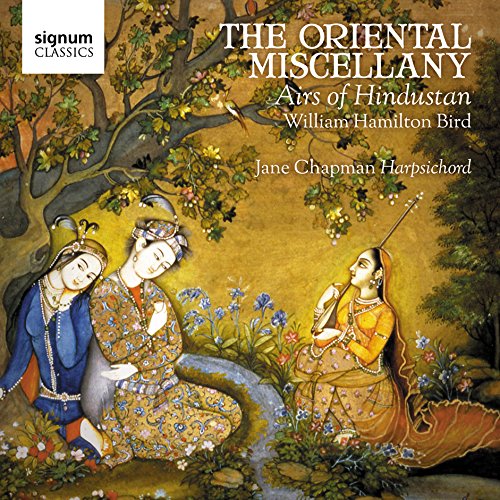William Hamilton Bird: The Oriental Miscellany
View record and artist detailsRecord and Artist Details
Composer or Director: Traditional
Genre:
Instrumental
Label: Signum
Magazine Review Date: 08/2015
Media Format: CD or Download
Media Runtime: 74
Mastering:
DDD
Catalogue Number: SIGCD415

Tracks:
| Composition | Artist Credit |
|---|---|
| Airs of Hindustan |
Traditional, Composer
Jane Chapman, Harpsichord Traditional, Composer |
Author: Philip Kennicott
Harpsichordist Jane Chapman has taken liberties with the original source, and for the most part they are welcome ones. In some cases, she has included extracts from another source, a collection of airs, which overlaps in places with Bird’s, by the contemporaneous harpsichordist Sophia Plowden. She also takes full advantage of the sonic effects and exotic possibilities of the restored 1772 Jacob Kirckman harpsichord she has chosen for the recording. The range of colours and textures is dazzling, and at times wonderfully suggestive of the Indian sitar. She is free with repetitions and ornamentation, and occasionally adapts the simple bass-line for greater dramatic effect.
Listeners, however, should be careful to consult the original score (available online at the IMSLP/Petrucci Music Library) to discover where Chapman’s delicious improvised additions begin and end, because they are some of the most appealing moments on the recording. Otherwise, the casual listener will be misled into believing that Bird’s ear for modal and harmonic colour, and his sensitivity to the more rhythmically dynamic and flexible Indian line, was far greater than it was. Bird’s adaptations have occasional moments that suggest he was alert to something intractably ‘other’ in the music – unresolved phrase endings, chromatic surprises – but most of what sounds genuinely ‘Indian’ here is attributable to Chapman’s smart framing of the originals.
Bird’s style is typical of the galant era, harmonically simple-minded, insouciant and musically appealing, with many of the airs followed by variations calling for fluent fingerwork. In his introduction to the original publication, Bird makes clear that he sought out in Indian music regularity, especially familiar rhythmic patterns, and he self-consciously avoided Indian styles that didn’t oblige. He wanted music that earned its welcome in a European social setting.
Chapman takes that mandate to heart, and even her more adventurous additions to Bird’s score can be justified as invigorating showmanship. The playing is smart, clean, refined and inventive. If one is looking primarily for musical authenticity, she provides it in this sense: the recording captures the European delight in exotica, especially its liberating power on musical fancy.
Discover the world's largest classical music catalogue with Presto Music.

Gramophone Digital Club
- Digital Edition
- Digital Archive
- Reviews Database
- Full website access
From £8.75 / month
Subscribe
Gramophone Full Club
- Print Edition
- Digital Edition
- Digital Archive
- Reviews Database
- Full website access
From £11.00 / month
Subscribe
If you are a library, university or other organisation that would be interested in an institutional subscription to Gramophone please click here for further information.




